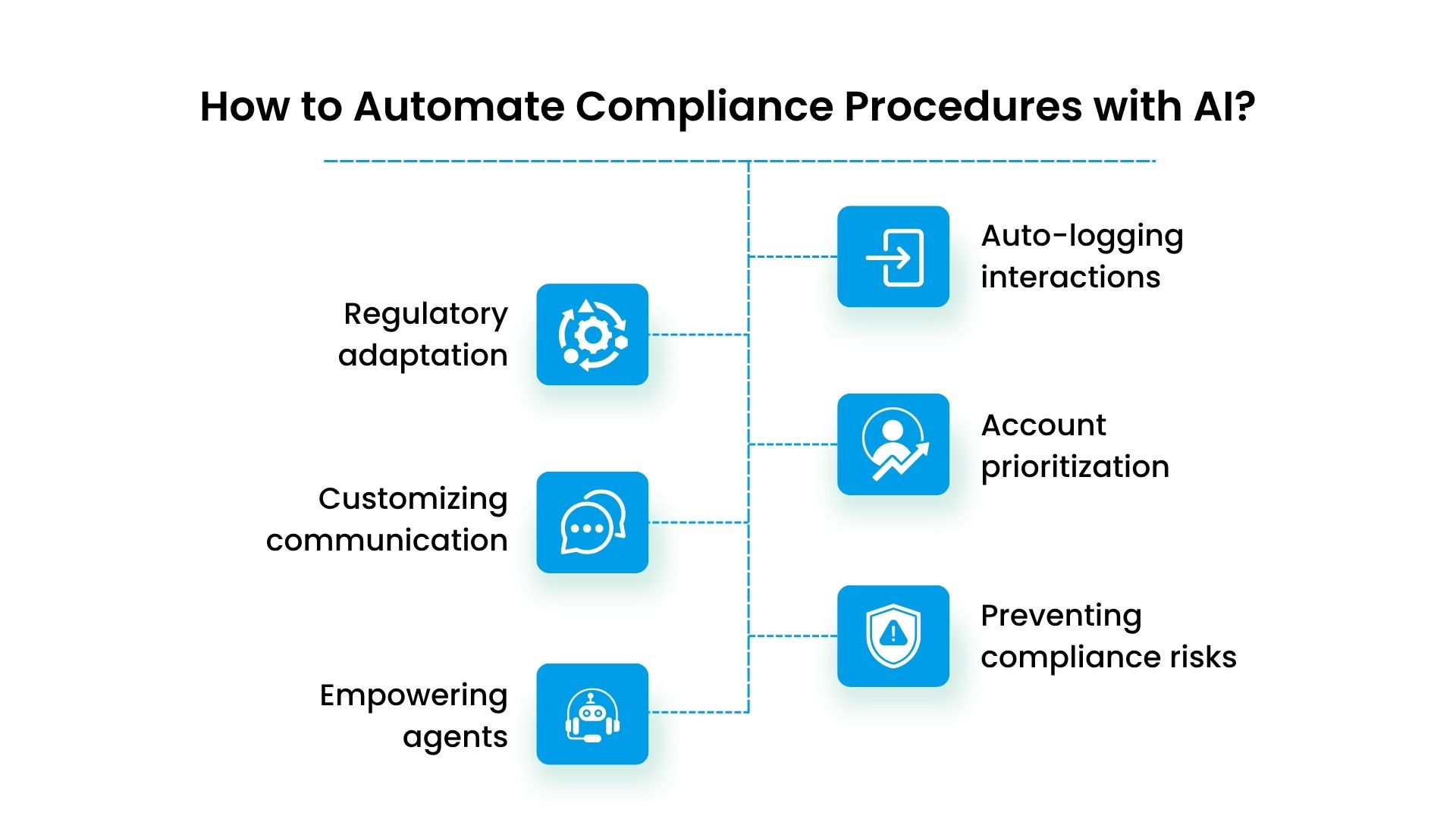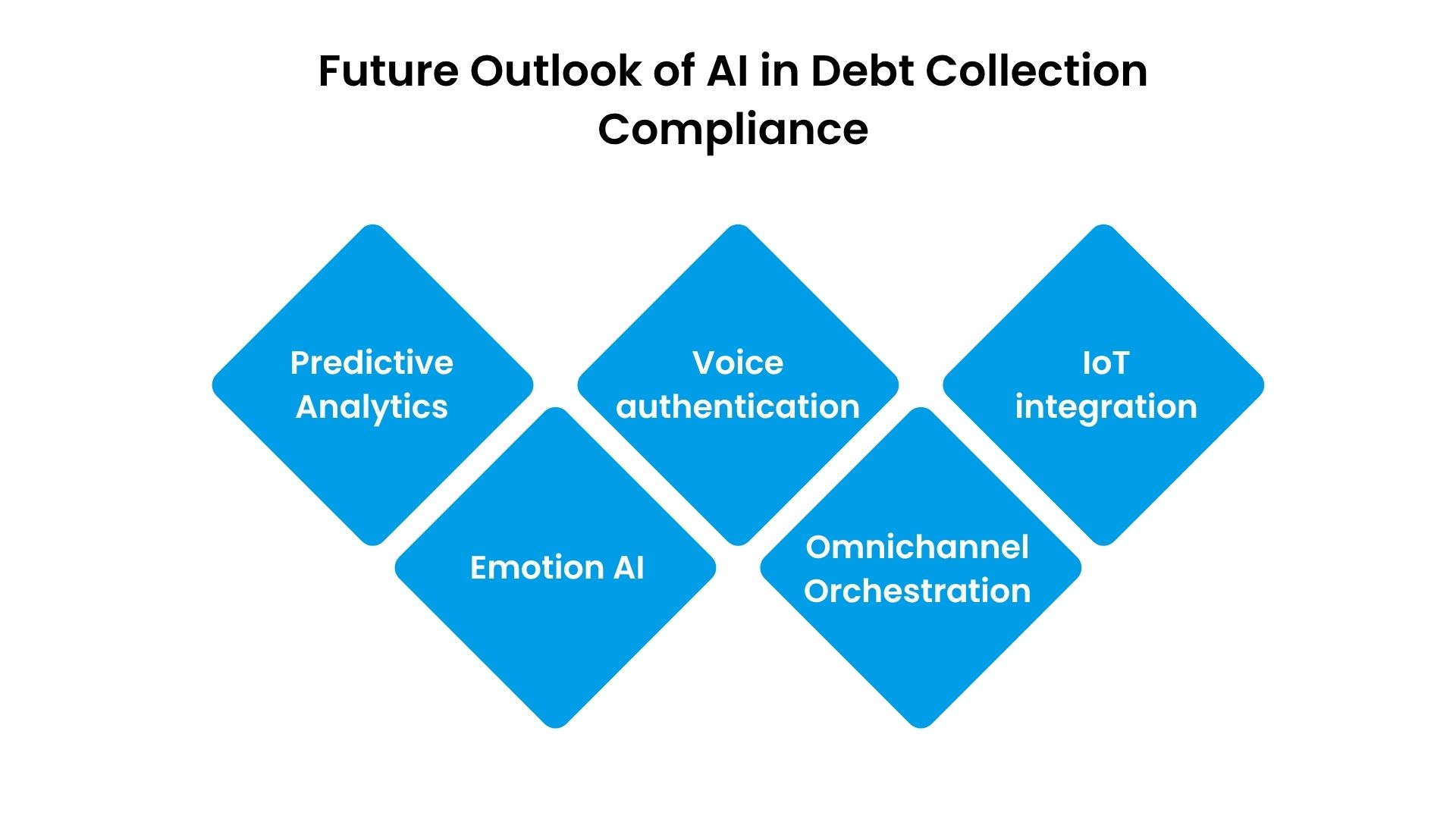The Role of Artificial Intelligence in Enhancing Compliance in Debt Collection

Transform Your Financial Future
Contact UsOne slip-up could cost you big. Here's how AI helps you stay compliant and efficient in debt collection.
Debt collection often feels like trying to keep up with moving targets. Regulations are constantly changing, and staying compliant can be a continuous struggle. With consumer rights growing in importance and rules getting stricter, both businesses and individuals find themselves overwhelmed, trying to balance overdue accounts and legal requirements.
But there's good news. Whether you're an individual managing debt, a small business handling receivables, or a financial institution aiming to improve efficiency, AI is the solution. It keeps you updated on real-time regulatory changes, refines your communication strategies, and ensures compliance, without stress.
In this blog, let's understand how AI is enhancing debt collection and how you can use it to reduce risks, stay compliant, and improve your financial results.
Key Takeaways
- AI automates compliance: Streamlines documentation, tracks regulatory updates, and reduces errors to ensure businesses stay compliant.
- Proactive risk management: AI flags non-compliant actions in real-time, helping businesses address issues before they escalate.
- Personalized communication: AI customizes debtor interactions, improving engagement and maintaining compliance.
- Predictive analytics: AI uses data to prioritize high-risk accounts, boosting recovery rates.
- The Forest Hill Management: Offers AI-powered solutions for portfolio management and acquisitions, simplifying compliance across operations.
How to Automate Compliance Procedures with AI?

In debt collection, compliance isn’t just a box to check it’s a moving target. Manual processes make it harder to keep up, and the risk of falling out of step with regulations is high. AI steps in by reducing human error, simplifying workflows, and making compliance feel less like a burden and more like built-in intelligence.
1. Logging Every Interaction Automatically
Manually tracking calls, emails, and payment updates? That’s where mistakes creep in. AI systems log every action as it happens automatically, and with timestamps.
This creates a reliable record that protects both your team and your business during disputes or audits. It also frees up staff to focus on follow-ups and strategy instead of scrambling to document everything after the fact.
2. Adapting Instantly to Regulatory Changes
Debt collection laws don’t stay still for long. AI tools plug directly into legal databases and update your compliance rules the moment regulations change.
This means your team isn’t stuck referencing outdated playbooks or relying on last month’s compliance memo. The system updates in real-time, ensuring everyone stays aligned without manual oversight.
3. Identifying the Right Accounts to Prioritize
Not every overdue account requires the same approach. AI analyzes past behavior, payment history, and credit data to help you spot which accounts are worth pursuing—and when.
That insight lets your team focus on the right conversations at the right time, improving recovery while maintaining a fair, legally sound approach.
4. Tailoring Communication to Each Debtor
AI tools can adjust tone, timing, and channel based on each debtor’s preferences. If someone responds better to emails in the afternoon rather than phone calls in the morning, your system learns and adapts.
This personalization isn’t just a nice touch; it can reduce complaints, increase engagement, and make your outreach more compliant with regulations like the FDCPA.
5. Catching Compliance Risks Before They Escalate
Think of AI as your compliance safety net. It scans communications and actions in real time, flagging anything that could raise red flags like improper language or timing violations.
That gives your team the chance to fix small issues before they become legal headaches or damage trust with consumers.
6. Giving Agents Better Tools (Not More Tasks)
AI isn’t here to replace your people it’s here to support them. By surfacing the right account history, payment behavior, and recommended next steps, AI helps agents have more informed, confident, and compliant conversations.
And when agents are equipped with better context, it shows in the results both in collection rates and customer satisfaction.
As AI becomes more integral in debt collection, ensuring it aligns with existing regulations and ethical standards is crucial. Now, let's take a closer look at how AI can uphold consumer rights and maintain transparency.
Regulatory Frameworks and Ethical Considerations

In AI-driven debt collection, businesses must keep pace with regulations and uphold ethical standards to protect consumers and stakeholders. Below are key areas where AI strengthens compliance.
1. Ensuring AI Complies with Existing Regulations
AI in debt collection must adhere to laws like the FDCPA and TCPA, protecting consumer rights. Automated tools ensure communications and practices remain compliant, reducing legal risks.
Example: AI misuse in debt collection can lead to misleading content like fake recordings, violating FDCPA regulations, and risking legal penalties. By using AI systems that are carefully designed to comply with regulations, businesses can avoid such risks and ensure adherence to legal standards.
2. Protecting Consumer Rights
AI safeguards consumer rights by keeping interactions respectful, transparent, and within legal boundaries. It tracks debtor preferences, avoiding unethical actions and respecting consumer protections.
Example: If a debtor prefers email over phone calls, the AI will automatically adjust its outreach method, reducing unwanted contact and complaints. Additionally, it can suggest flexible payment options or temporary relief plans.
3. Building Stakeholder Trust
Transparency is vital for effective AI in debt collection. Open communication about AI usage builds trust with consumers, regulators, and investors, reflecting fair and responsible practices.
Example: AI compliance debt collection reports and transparent communication logs can be shared with regulators, investors, and consumers to demonstrate fair, responsible, and auditable debt collection practices.
As we look at the regulatory landscape and consumer protection, it’s important to recognize the challenges businesses face when implementing AI in debt collection.
Challenges and Limitations of AI in Compliance
While AI can enhance debt collection practices, businesses must address several challenges to ensure that AI-driven processes remain both compliant and effective. Below, we examine these challenges and offer solutions to provide a seamless and compliant integration of AI in debt collection.
1. Overcoming Technical and Operational Challenges
Many businesses still rely on legacy systems, making it challenging to implement AI effectively. This can lead to inefficiencies and disruptions in operations.
Solution: Implement a gradual integration strategy, focusing on areas where AI can add the most value, such as automating documentation and conducting AI compliance debt collection checks. Ensure that IT teams are trained to manage AI tools effectively.
2. Data Privacy Concerns
AI systems often require access to vast amounts of sensitive consumer data, raising concerns about data privacy and the risk of breaches. With regulations like GDPR and CCPA, businesses must ensure that AI systems comply with stringent privacy laws to avoid legal consequences.
Solution: Implement strong data protection strategies like encryption and secure storage, ensuring compliance with regulations like GDPR. Always obtain explicit consent and be transparent about data usage.
3. Managing New Obligations
Governments are continuously updating data protection and debt collection regulations, such as the FDCPA and TCPA, to address the evolving role of AI. Businesses may find it difficult to keep up with these changes and adapt their systems accordingly.
Solution: Stay ahead by establishing a compliance monitoring system that tracks legal updates. Utilize AI tools to automatically adjust policies and practices in real-time to meet evolving regulations.
4. Cross-functional Responsibility
AI implementation in debt collection requires collaboration across multiple departments, including IT, compliance, customer service, and legal teams. Ensuring that everyone is aligned and understands their role in maintaining AI compliance debt collection can be a challenge, primarily when departments work in silos.
Solution: Foster cross-functional collaboration by establishing teams responsible for AI integration. Hold regular training sessions to ensure all departments are aligned and aware of their role in maintaining compliance.
With a clear understanding of the challenges, it's time to look ahead and explore the future of AI in debt collection compliance. Let's take a look at the exciting innovations that will shape the next generation of AI-powered debt recovery.
Future Outlook of AI in Debt Collection Compliance

The future of AI in debt collection is poised to introduce even more transformative changes, further enhancing compliance, efficiency, and customer experience. Here's a look at the next-generation AI technologies shaping debt collection practices.
1. Predictive Analytics
Predictive analytics will continue to enhance AI's ability to forecast debtor behavior, improving collection strategies and compliance.
2. Emotion AI
Emotion AI will be utilized to analyze the emotions of debtors during interactions, ensuring that debt collection practices provide a more personalized and empathetic approach.
3. Voice Biometrics and Authentication
Voice biometrics will enhance authentication and security. By verifying the identity of the debtor during phone calls, businesses can prevent fraudulent claims and ensure that all communications comply with regulations, such as the TCPA.
4. Omnichannel Orchestration
AI will play a significant role in orchestrating omnichannel strategies, ensuring that debt collection remains compliant across all communication channels.
5. Integration with IoT and Smart Devices
The future of AI in debt collection will also involve integration with IoT devices, enabling businesses to monitor debtor behaviors across various touchpoints for better decision-making.
By incorporating the above modern technologies, businesses can enhance their AI compliance debt collection practices while ensuring adherence to legal and ethical standards.
How The Forest Hill Management Helps to Automate Debt Collection Compliance
Debt collection compliance can be complex, but The Forest Hill Management simplifies it with AI-powered solutions that streamline processes and ensure efficiency.
Here's how:
- Portfolio Management: Tracking overdue payments and ensuring compliance is made easier with automated reporting and tracking, reducing errors and freeing you to focus on strategic decisions.
- Portfolio Acquisitions: Acquiring portfolios can be complex, but The Forest Hill Management simplifies the process by handling due diligence and ensuring smooth, compliant transitions, reducing risks.
- Compliance Monitoring and Updates: Stay on top of regulatory changes with automatic updates, removing the need for constant manual adjustments.
- Customized Compliance Solutions: Every business has unique needs. The Forest Hill Management provides flexible, scalable solutions that adapt to your specific challenges, ensuring continued compliance as you grow.
Get in touch today to get personalized financial advisory services and technology solutions to help you stay compliant and improve your recovery rates.
Conclusion
As regulations become more complex and consumer expectations rise, AI-driven solutions offer a sustainable path forward, ensuring businesses stay compliant while optimizing their collections. By implementing AI technologies such as predictive analytics, emotion AI, and voice biometrics, companies can not only meet regulatory requirements but also build stronger, more empathetic relationships with consumers.
Take the next step toward enhancing your AI compliance debt collection practices with strategic solutions. At The Forest Hill Management, you get the right tools and support you need for debt management.
FAQs
1. Can I use AI to get out of debt?
AI compliance debt collection tools can help you manage debt by automating reminders and offering personalized repayment plans. While AI aids in organizing and communicating, it cannot directly eliminate debt. Its primary role is to help streamline debt resolution.
2. What are the AI tools for collections?
AI tools for collections include automated systems that manage payments, predict debtor behavior, and ensure compliance with legal standards. These tools enhance efficiency by reducing errors and improving communication with debtors, ensuring fair and lawful debt recovery.
3. How to remove debt without paying?
There is no legitimate way to remove debt without paying. AI compliance debt collection systems can help you negotiate payment plans, automate reminders, and ensure fairness during the process, making debt management easier and compliant with regulations.
4. What is the 777 rule with debt collectors?
The "777 rule" refers to delaying debt collection by ignoring attempts for seven days. AI compliance debt collection systems help businesses follow legal guidelines in all communications, ensuring fairness and compliance with the FDCPA and TCPA, even if collection efforts are delayed.
-p-500%20(1).png)